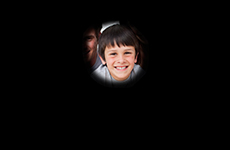Usher Syndrome
What is Usher Syndrome?

Usher Syndrome is the most common condition affecting both vision and hearing. It is a rare genetic disorder that is the main cause of deaf-blindness. The major symptoms of Usher Syndrome are loss of hearing and an eye condition called Retinitis Pigmentosa.
Usher Syndrome is a variable condition in which the degree of severity is not linked to what clinical type someone has. Of those people affected by Retinitis Pigmentosa, approximately one-sixth have Usher Syndrome.
Usher Syndrome is an inherited condition, meaning it is genetic. It is a recessive condition, meaning that both parents must carry the gene in order for a person to get this syndrome.
Discover our visual aids for Usher syndrome.

Normal vision vs. Usher Syndrome
Usher Syndrome can be categorized into three clinical types:
Usher type I
People with Usher Syndrome type I are born profoundly deaf and begin to lose their vision in the first decade of life. They also show balancing difficulties and are impaired in their ability to learn how to walk.
Usher type II
People with Usher Syndrome type II are not born deaf, but they do have hearing loss. They do not seem to have noticeable problems with balance and begin losing vision in the second decade of life. Vision may be preserved until middle age.
Usher type III
People with Usher Syndrome type III are not born deaf. They experience a gradual loss of hearing and vision and may or may not have balance difficulties.

Usher syndrome type I |

Usher syndrome type II |
What are the symptoms of Usher Syndrome
Symptoms of Usher Syndrome include:
- deafness or increasing loss of hearing
- Retinitis Pigmentosa
- difficulties in balancing
- tunnel vision
What to expect from Usher Syndrome
Usher Syndromeis currently not a curable disorder. The best treatment involves early diagnosis, so that educational programs can begin as soon as possible. The exact nature of such programs will depend on the severity of the hearing and vision loss. Treatment may also include the use of hearing aids, assistive listening devices, implants, other communication methods, orientation and mobility training and low vision or Braille services.
More information about Usher Syndrome
There is extensive information available about Usher Syndrome. The information included is intended to inform you about the basics of this eye conditin, and is not intended as a replacement for information from your physician or eye specialist. Information regarding assistive devices that can help you if you have been diagnosed with Usher Syndrome is included. Our recommendations can be found under Tools and Resources.








